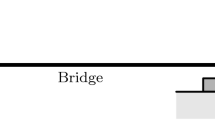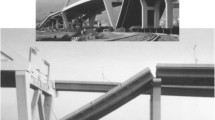Abstract
This paper presents the dynamic soil–bridge interaction under high-speed railway lines, under different soil stiffness conditions. Starting from the analysis of a simply supported Euler–Bernoulli beam model subjected to moving loads, a three-dimensional multi-body (soil–abutment–bridge–ballast–sleeper–rail) model formulated in the time domain to study the vibrations induced due to the passage of moving concentrated loads was analysed using the direct finite element method of soil–structure interaction analysis. The high-speed train was considered to be a set of concentrated loads, the rail was modelled as a Euler–Bernoulli beam (frame element), and the sleepers, ballast, bridge, abutments and soil were modelled using eight-node solid (brick) elements. Layered soil stratum’s effects on the dynamic response of the bridge deck and variation of stresses were studied. From this study, it was observed that the direct method of FE analysis can be an effective tool to solve the complex dynamic soil–structure interaction problems.

















Similar content being viewed by others
References
Biondi B, Muscolino G, Sofi A (2005) A substructure approach for the dynamic analysis of train-track-bridge system. Comput Struct 83(28–30):2271–2281
Cheng YS, Au FTK, Cheung YK (2001) Vibration of railway bridges under a moving train by using bridge-track-vehicle element. Eng Struct 23(12):1597–1606
Chopra AK (2008) Dynamics of structures theory and applications to earthquake engineering, 3rd edn. Prentice Hall of India, New Delhi
Cook RD, Malkus DS, Plesha ME, Witt RJ (2004) Concepts and applications of finite element analysis, 4th edn. Willey, Hoboken
Delgado RM, Cruz S (1997) Modelling of railway bridge–vehicle interaction on high-speed tracks. Comput Struct 63(3):511–523
Doménech A, Museros P (2011) Influence of the vehicle model on the response of high-speed railway bridges at resonance. Analysis of the additional damping method prescribed by Eurocode 1. In: Proceedings of the 8th international conference on structural dynamics, EURODYN 2011, pp 1273–1280
European Committee for Standardisation (CEN) (2008) Eurocode1: actions on structures—part 2: traffic loads on bridges
Frýba L (2001) A rough assessment of railway bridges for high-speed trains. Eng Struct 23(5):548–556
Hanazato T, Ugai K, Mori M, Sakaguchi R (1991) Three-dimensional analysis of traffic-induced ground vibrations. J Geotech Eng ASCE 117(8):1133–1151
Henriques J (2007) Dynamic behaviour and vibration control of high-speed railway bridges through tuned mass dampers. Dissertation report for the degree of Master of Science in Civil Engineering
Ju SH, Lin HT (2003) Resonance characteristics of high-speed trains passing simply supported bridges. J Sound Vib 267(5):1127–1141
Kausel E, Roesset M (1977) Semianalytic hyperelement for layered strata. J Eng Mech ASCE 103(4):569–588
Kausel E, Roesset M, Waas G (1975) Dynamic analysis of footings of layered media. J Eng Mech ASCE 101(5):679–693
Liu K, Roeck GD, Lombaert G (2009) The effect of dynamic train–bridge interaction on the bridge response during a train passage. J Sound Vib 325(1–2):240–251
Lysmer J, Waas G (1972) Shear waves in plane infinite structures. J Eng Mech ASCE 98(1):85–105
Martı´nez-Rodrigo MD, Museros P (2011) Optimal design of passive viscous dampers for controlling the resonant response of orthotropic plates under high-speed moving loads. J Sound Vib 330(7):1328–1351
Museros P, Alarcón E (2005) Influence of the second bending mode on the response of high-speed bridges at resonance. J Struct Eng 131(3):405–415
Museros P, Martı´nez-Rodrigo MD (2007) Vibration control of simply supported beams under moving loads using fluid viscous dampers. J Sound Vib 300(1–2):292–315
Pesterev AV, Bergman LA, Tan CA, Tsao TC, Yang B (2003) On asymptotics of the solution of the moving oscillator problem. J Sound Vib 260(3):519–536
Pyl L, Degrande G, Clouteau D (2004a) Validation of a source–receiver model for road traffic induced vibrations in buildings. II: receiver model. J Eng Mech ASCE 130(12):1394–1406
Pyl L, Degrande G, Lombaert G, Haegeman W (2004b) Validation of a source–receiver model for road traffic induced vibrations in buildings. I: source model. J Eng Mech ASCE 130(12):1377–1393
Rajasankar J, Nagesh RI, Yerraya Swamy B, Gopalakrishnan N, Chellapandi P (2007) SSI analysis of a massive concrete structure based on a novel convolution/deconvolution technique. Sadhana 32(3):215–234
Romero A, Solís M, Domínguez J, Galvín P (2013) Soil–structure interaction in resonant railway bridges. Soil Dyn Earthq Eng 47:108–116
SAP2000 v14.2.4. (2014) Integrated software for structural analysis and Design. User’s manual. http://www.csiberkeley.com/products_SAP.html. Accessed 10 Jan 2016
Song C, Wolf JP (1996) Consistent infinitesimal finite-element cell method: three dimensional vector wave equation. Int J Numer Methods Eng 39:2189–2208
Song MK, Noh HC, Choi CK (2003) A new three-dimensional finite element analysis model of high-speed train–bridge interactions. Eng Struct 25(13):1611–1626
Teng YF, Teng NG, Kou XJ (2008) Vibration analysis of continuous maglev guideway considering the magnetic levitation system. J Shanghai Jiaotong Univ (Sci) 13(2):211–215
Ülker-Kaustell M, Karoumia R, Pacoste C (2010) Simplified analysis of the dynamic soil–structure interaction of a portal frame railway bridge. Eng Struct 32:3692–3698
von Estorff O (1991) Dynamic response of elastic blocks by time domain bem and fem. Comput Struct 38(3):289–300
Wang Y, Wei QC, Shi J, Long X (2010) Resonance characteristics of two-span continuous beam under moving high-speed trains. Lat Am J Solids Struct 7:185–199
Wolf JP (1985) Dynamic soil–structure interaction. Prentice-Hall Inc, New Jersey
Wolf JP (1986) A comparison of time domain transmitting boundaries. Earthq Eng Struct Dyn 14:655–673
Wolf JP (1988) Soil–structure-interaction analysis in time domain. Prentice Hall, New Jersey
Wu YS, Yang YB, Yau JD (2001) Three-dimensional analysis of train–rail–bridge interaction problems. Veh Syst Dyn 36:1–35
Xia H, De Roeck G, Zhang N, Maeck J (2003) Experimental analysis of a high-speed railway bridge under Thalys trains. J Sound Vib 268(1):103–113
Xia H, Zhang N, Gao R (2005) Experimental analysis of railway bridge under high-speed trains. J Sound Vib 282(1–2):517–528
Xia H, Zhang N, Guo WW (2006) Analysis of resonance mechanism and conditions of train bridge system. J Sound Vib 297(3–5):810–822
Yang YB, Yau JD (1997) Vehicle–bridge interaction element for dynamic analysis. ASCE J Struct Eng 123(11):1512–1518
Yang YB, Yau JD, Hsu LC (1997) Vibration of simple beams due to trains moving at high-speeds. Eng Struct 19(11):936–944
Yang YB, Chang CH, Yau JD (1999) An element for analysing vehicle-bridge systems considering vehicle’s pitching effect. Int J Numer Methods Eng 46(7):1031–1047
Yang YB, Yau JD, Wu YS (2004) Vehicle–bridge interaction dynamics with applications to high-speed railways. World Scientific, Singapore
Yau JD, Yang YB, Kuo SR (1999) Impact response of high-speed rail bridges and riding comfort of rail cars. Eng Struct 21(9):836–844
Author information
Authors and Affiliations
Corresponding author
Rights and permissions
About this article
Cite this article
Gharad, A.M., Sonparote, R.S. Study of Direct Finite Element Method of Analysing Soil–Structure Interaction in a Simply Supported Railway Bridge Subjected to Resonance. Iran J Sci Technol Trans Civ Eng 43, 273–286 (2019). https://doi.org/10.1007/s40996-018-0139-7
Received:
Accepted:
Published:
Issue Date:
DOI: https://doi.org/10.1007/s40996-018-0139-7




